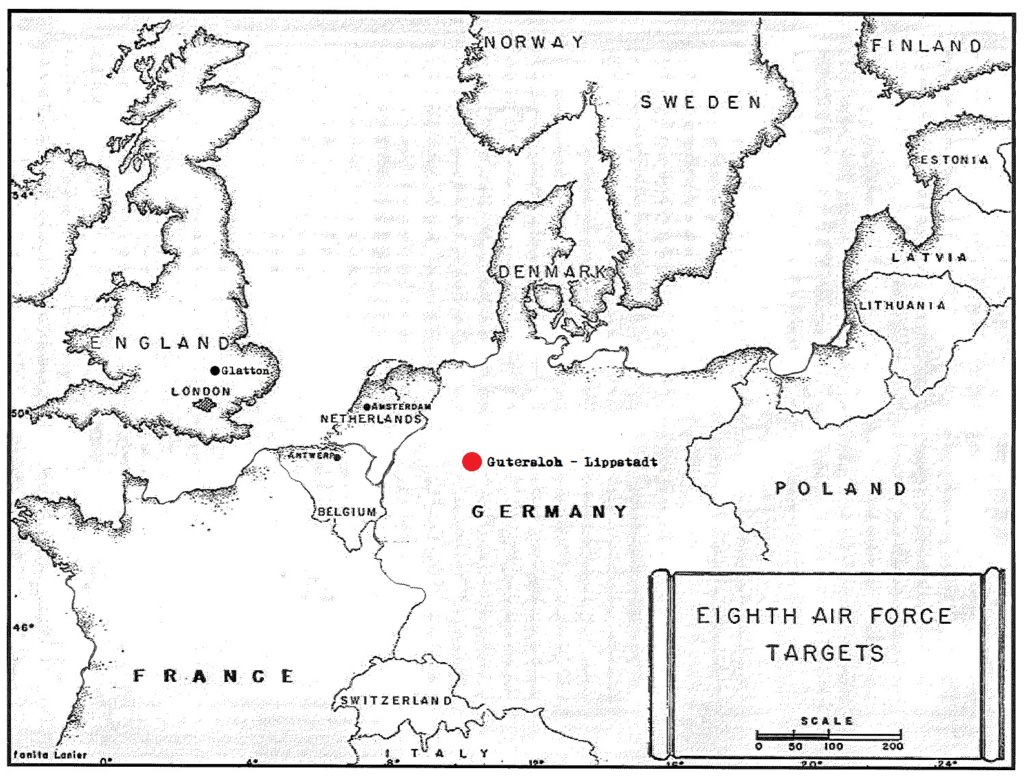TARGET: AIRBASE
GUTERSLOH – LIPPSTADT, GERMANY
21 FEBRUARY 1944

The first mission of the 457th was flown on the second day of The Big Week to Gutersloh and Lippstadt. The total operation of the day for the Eighth Air Force was directed against Brunswick, Diephol; Achmer, Gutersloh and Lippstadt. The 457th operation was flown in two formations, A and B. The A Formation, consisting of nineteen aircraft, assigned to fly the high box in the 94th A Combat Wing, and was dispatched to Gutersloh. The B Formation consisting of seventeen aircraft, went to Lippstadt. Both were airparks for the storing of enemy fighters. The A Formation was led by Col. Luper with Lt. J. L. Smith, pilot. Major Henry B. Wilson, Deputy Group Commander, led the B Formation with Lt. Vinton H. Mays as pilot.
The A Formation failed to assemble with the 94th A Combat Wing (CBW), but joined with the 41st CBW. Its target was an Airdrome near Hamm.
Bombing results were nil. A complete undercast obscured the target and when the Wing Leader dropped on a target of opportunity in the target area, twelve ot the crews released bombs. The Group Leader and other planes held their bombs, and failing to find a better target, returned to the Base.
A solid undercast prevented the B Formation, flying the high box of the 94th B Combat Wing, from dropping bombs as no PFF (radar equipped) aircraft was provided. The Formation leader searched for a target of opportunity. Finding none, the formation jettisoned bombs in the North Sea, a short distance from the Dutch Coast.
Notwithstanding the bombing results, two significant events occurred on the mission. Lt. Llewellyn (Lew) G. Bredeson, flying aircraft No 42-31596, was shot down on the bomb run, becoming the first 457th crew to be lost in combat.
The plane of Lt. Edward B. Dozier, who was to become one of the 457th’s lead pilots, was attacked by four enemy fighters and was shot up so badly it had to be salvaged. The entire tail was badly damaged. Practically all the controls were gone, the oxygen system was out and the communications system was gone.
In spite of the riddled condition of the ship, Lt. Dozier brought the plane back, making a good landing. The tail gunner, Sgt. Hyman Kaib, and the waist gunner, Sgt. Dwight Anderson, were credited with downing an FW-190. The radio operator, Sgt. Seymour Pliss, died from flak wounds.
Lt. Dozier later was awarded the Distinguished Flying Cross for the courage, coolness, expert skill and superior airmanship he displayed.
(Compiler ‘s Note: Both aircraft were in the A Formation) The mission was summed up as an interesting introduction into the many factors that can complicate and affect a bombing mission in this theater.

